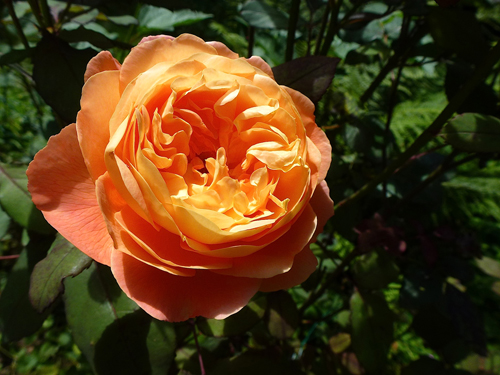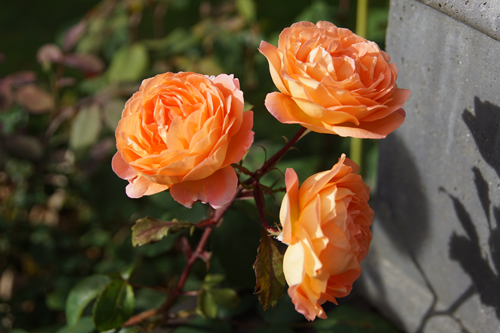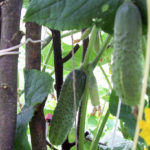Rose Lady Emma Hamilton (Lady Emma Hamilton)
Of the many varieties of the queen of flowers, English roses stand out especially. They took all the best from the most common groups of ornamental plants: harmonious bush shape, species characteristics of old varieties, long flowering and high resistance to diseases. Meet the novelty of the last decade - the English beauty, who bears the noble name of Lady Emma Hamilton.

History of origin
The variety appeared in 2005. Its author was the famous British breeder David Austin - the creator of a unique nursery, more like an open-air rose garden. Our heroine was named after the charming darling of Admiral Nelson, who accompanied the lord to the Battle of Trafalgar at the beginning of the century before last. Two years after its appearance, the beautiful flower was presented in America, where it became the object of close attention of rose growers. Lady Emma Hamilton is a Prix International laureate in Nantes, France for her unparalleled fragrance. In 2010, the culture won the Nagaoka Rose Trials and Nantes Rose Trials. This is one of the favorite creations of the author of the variety. The culture's registration name is "AUSbrother".
Description
Lady Emma Hamilton belongs to the English musk rose hybrids and the scrub class. The variety is not too tall (75-100 cm, maximum 1.5 meters), strong, branched bush with erect shoots. Its crown can reach a width of 90 cm. The plant has unusual bronze colored foliage. It becomes green only as the perennial grows older. The leaves of a bush beauty are of medium size, with a matte surface.
The flowers of the aristocrat Lady Emma Hamilton are not quite common for an English rose in terms of shade. Being in the phase of complete dissolution, they are sustained in eye-pleasing tangerine-yellow tones with pink notes. The color of the buds is somewhat different: red, with orange splashes. The flowers of this plant are cupped, double and rather large, from 10 to 12 cm in diameter. They are collected in racemose inflorescences of 3-5 pieces. The number of petals in each of the buds reaches 45. The inflorescences are very fragrant. Their pleasant fruity scent combines the scent of pears, citrus fruits and grapes.

The variety belongs to fast growing crops. It produces buds throughout the summer, from June to September, but the flowering of the perennial is wave-like. The first wave is the most abundant; later, the flowering intensity decreases markedly. Advantages of our heroine: good frost resistance (not afraid of dropping temperatures down to -29 ° C), increased drought resistance, immunity to fungal and bacterial diseases, excellent endurance. Lady Emma Hamilton is not suitable for cultivation in regions with rainy, cold summers, as it rarely blooms under such conditions.
Agrotechnical features
An English flower with pronounced features of antique roses can be planted in a sunny place. But due to the tenderness of the petals and the rapid appearance of burns on them, the plant should not be allowed to be in direct sunlight throughout the day - in the afternoon, Lady Emma Hamilton needs light shading. For planting a culture, they choose a place on a hill so that in the future the flower does not become a victim of stagnant moisture in the soil. The sophisticated creature prefers light, fertile, breathable soil with a pH ranging from 5.6 to 6.5.
Favorable time for planting a perennial: April-May. The width and depth of the hole should be about 60 cm. Do not forget about the layer of drainage material at the bottom of the planting hole. Recommended drainage thickness: 10-15 cm. After planting the plant, watered it, and the soil around it is covered with mulch (peat).

The noble English rose, like any other of its relatives, requires the most basic care procedures: regular loosening of the soil under the flower, systematic moistening of the substrate, weeding, fertilizing and pruning.Watering our heroine is shown morning or evening with lukewarm, settled water. Fertilizers are required to be applied depending on the season: in the spring - nitrogen, in the summer - mineral. Pruning is carried out for sanitary purposes.
It is imperative that the young plant does not bloom early in the year of planting. To this end, all the buds are cut off on the bush during the summer. Only in August, 1-2 flowers are left on each stem of Lady Emma Hamilton. This measure contributes to the better ripening of the shoots and good wintering of the rose, and also ensures its lush flowering for the next year. Despite the good winter hardiness, Lady Emma Hamilton needs shelter for the winter. To do this, you can use any non-woven insulation or spruce branches, but first you should sprinkle the base of the bush with earth.
Use cases
There are a lot of ways to decorate a front garden or flower garden with an English rose. It can be planted near a gazebo, garden bench, along a garden fence or a building wall, including at the front of a dwelling. This culture is a welcome plant in a garden bed, as it blooms for a long time, and the buds of this hybrid retain their neat appearance throughout the season. Austin's exquisite creation is used by landscape designers to decorate mixborders, as a tapeworm on a green lawn. Shrubs of this variety can often be seen along paths in rose gardens or parks. They are ideal for dividing a recreation area into zones, suitable for alpine slides and rockeries. A fragrant rose will look great in the foreground of the site.
In group compositions, Lady Emma Hamilton goes well with cereals, tall grasses, bulbs and plants with decorative foliage. From flowering crops, the best companions for the British rose will be cuffs, ageratum, irises, purslane, geranium, bell, gladiolus, clematis. Lady Emma Hamilton is grown not only in the open field, but also in containers, flowerpots, displayed on an open veranda, balcony.









For me, this variety was a complete disappointment - I bought a seedling, "buying" beautiful photographs. The roses in the photo always turn out spectacular - they are beautifully folded, the petals are of a bright (unreal) copper-orange hue, but in reality everything is not so - the buds bloom too quickly: the roses are beautiful in the morning, and by the evening they turn into hanging rags of an incomprehensible dirty shade ... With the immunity of the variety, everything is bad - it constantly suffers from fungal infections, but about frost resistance - it's true, it is high, but nevertheless, you need to plant a seedling with a good deepening of the graft site (at least 10 - 15 cm).
Good day. My rosette Emma is 3 years old. Yes, it crumbles quickly and grows slowly. But! Magic aroma and wonderful color! I have 8 Ostinoks, I love everything, but this one is my favorite.